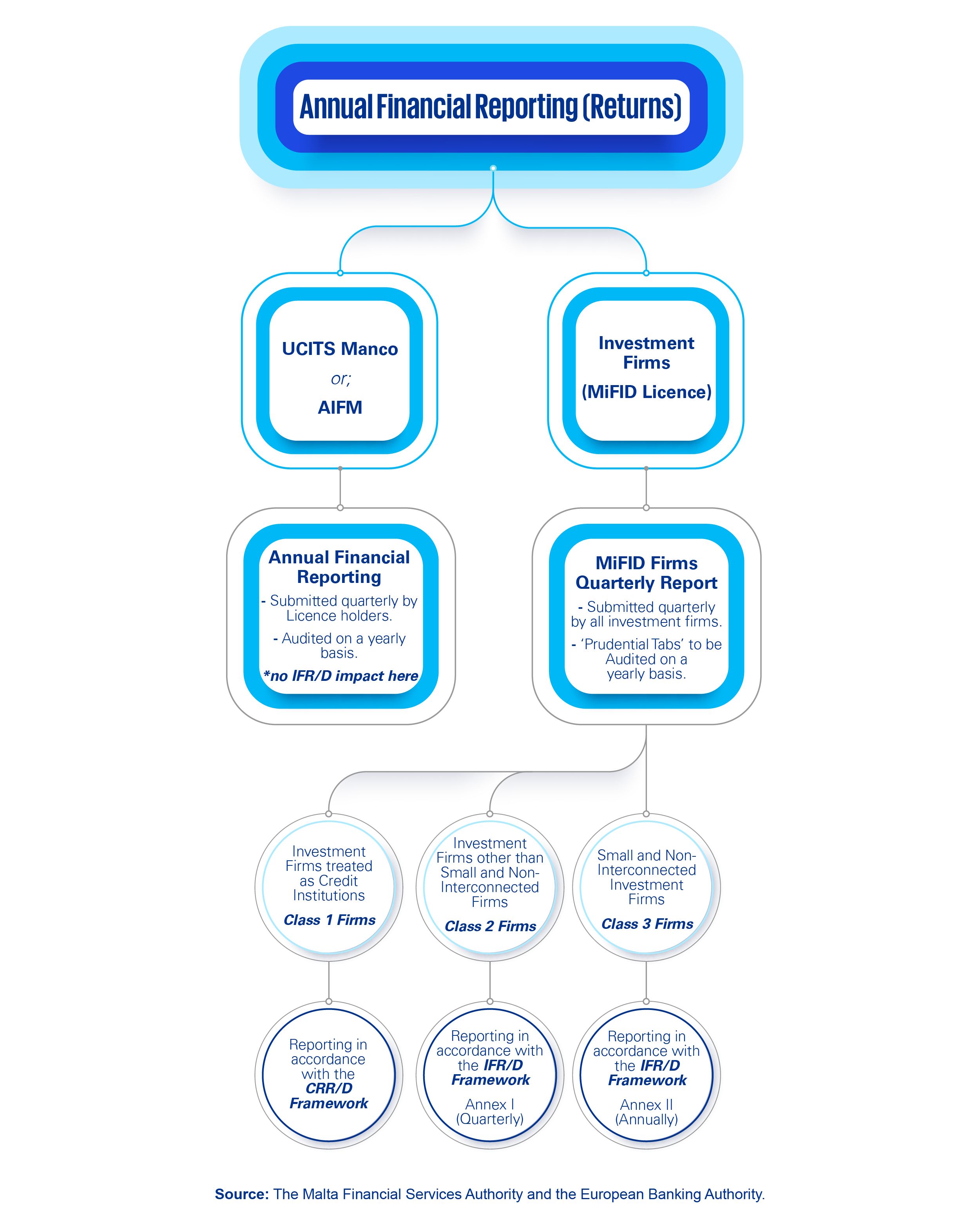Background
Investment firms authorised under the Markets in Financial Instruments Directive (“MiFID”) provide a range of services and activities to investors in financial markets. The population of Investment Firms across the EU is diverse, and firms vary greatly in terms of size, business model, activities undertaken, risk profile, complexity, and interconnectedness.
In 2019, the European Commission developed a new prudential Framework, consisting of the Directive (EU) 2019/2034 (“IFD”) and the Regulation (EU) 2019/2033 (“IFR”), collectively referred to as (“IFR/IFD Framework”) to better factor in the diversity of business models, operations and risks such EU investments firms are exposed to. The new IFR/IFD Framework was incepted to create a more appropriate Framework for Investment Firms. The main aims are to ensure the safe functioning of Investment Firms, strengthening their soundness and stability, and better managing their risks towards customers, the market, and the firms themselves. The Framework also ensures to do this while maintaining systemic Investment Firms (the largest type) to fall under the prudential requirements and supervision of the Capital Requirements Regulation and Capital Requirements Directive (“CRR/CRD Framework”).
Scope and Applicability
The IFR/IFD Framework applies to Investment Firms authorised and supervised under Directive 2014/65/EU (“MiFID II”) and de-minimis Alternative Investment Fund Managers (‘AIFMs’) providing MiFID services. The IFR/IFD Framework does not apply to Credit Institutions, even when these offer MiFID ancillary services, full-scope UCITS Management Companies and AIFMs.
Applicability can become tricky in certain cases; were you have certain firms offering a variety of services which may be impacted by an overlap from different regulatory regimes. The local competent Authority, the Malta Financial Services Authority (“MFSA”), in its quest to better guide the industry in this regard, issued a series of communications to inform the investment services licence holders about the changes relating to this prudential regulation for Investment Firms.
IFR/IFD Framework Impact and Changes
The new prudential regime introduced a range of new and/or enhanced disclosure and reporting requirements for in-scope Investment Firms. The purpose of these new requirements is to ensure that such firms are managed in an orderly way and in the best interests of their clients and to ensure the safety and soundness of Investment Firms while avoiding the imposition of a disproportionate administrative burden hence, introducing proportionate and risk-sensitive rules for Investment Firms. This effectively meant that most Investment Firms in the EU would no longer be subject to rules that were originally designed for Credit Institutions, with one exception to the largest and most systemic Investment Firms, which however, remains subject to the same prudential regime as European Credit Institutions (i.e. the CRR/CRD Framework).
The main changes brought forward with the new IFR/IFD Framework encompasses the Investment Firms’ supervisory review process, supervisory reporting, disclosure requirements, variable remuneration policies, governance, mandates related to economic, social and governance (ESG) risks and supervisory convergence. However, two major changes were in relation to the firms' classification and capital requirements and composition calculations.
The new framework established a reclassification system for Investment Firms according to their business activity and therefore the risks they are exposed to. Investment firms are now classified into three classes and one subclass, namely;
- Class 1 including the sub-classification of Class 1 Minus;
- Class 2 and;
- Class 3.
The largest systemic Investment Firms (Class 1 Firms) will continue to apply the current CRR/CRD Framework, whilst the new prudential regime will apply to Investment Firms that are not considered systemic by virtue of their size and/ or interconnectedness within the wider financial system, i.e. primarily Class 2 Firms. Small and non‐interconnected Investment Firms (Class 3 Firms) may receive regulatory requirements exemptions from their competent authorities, on an evaluation and case by case basis. Firms were expected to established their new classification and communicated this to the Regulator by Q4 2021.
Another major change is in relation to the firms’ own funds requirement and composition calculations, which is likely to be found to be more honourous under the new framework. The new capital requirements now introduce quantitative indicators (the “K-Factors”) to accurately reflect the risks which Investment Firms face. There are three groups of K-Factors: the risk to customers, risk to market access, and risk to the firm itself. Class 2 firms will be required to calculate their capital requirement using the K-Factors, whilst Class 3 Investment Firms will have to monitor the related metrics to ensure they have not reached their categorisation threshold. In the instance of a latter scenario, a re-classification exercise would need to be undertaken.
Reporting Requirements
The prudential reporting framework was reshaped under the new IFR/IFD Framework. The format in which Investment Firms will have to report the applicable annexes also changed to the global format used for exchanging business information, better known as "XBRL", which ultimately will make way to the European Banking Authority.
These new reporting requirements became applicable as from Q3 2021 for all firms having their accounting year-end as at 31 December 2021. For Investment Firms with different accounting year-end, the new reporting Framework becomes applicable once the reporting period covers at least three months under IFR/IFD Framework applicability.
The local Regulator informed the industry that as from Q3 2021, all the Investment Firms providing MiFID services to retail, professional and/or eligible counterparties were required to submit a new report titled “MiFID Firms Quarterly Reporting” (the “MFQR”). The MFQR is comprised of three main sections namely:
- Part A related to Conduct Data
- Part B related to Prudential Data
- Part C related to Exposure to Maltese Banks
This meant that the Conduct-Related Data, previously included in the Conduct-Related Data Return (for former Category 1 Investment Services Licence Holder and Credit Institutions licensed in terms of the Investment Services Act) and within the COREP Return (for the former Category 2 and Category 3 Investment Services Licence Holders), will need to be submitted in this new separate report. The MFQR also includes a number of prudential tabs to cover financial information that was captured in the previous COREP Return but is not captured in the European Banking Authority’s XBRL return.
Going forward, the MFQR is to be submitted within 42 days after the end of the applicable reporting period with the prudential tabs within the annual (Q4) MiFID Firms Quarterly Report required to be audited by the firm’s external auditor and submitted to the Regulator (including the auditor’s report) by not later than four months after the accounting reference date.
The flowchart below aims to facilitate the reporting requirements applicable according to the new IFR/IFD Framework:

Impact and Going Forward
The Regulator carried out significant changes to ensure proper transposition and implementation of the IFR/IFD Framework, along with various other Regulations and Directives. This is also keeping in mind that the new IFR/IFD Framework altered the ‘old’ categories for Investment Services Licence Holders and introduced ‘new’ classes for the same.
The Regulator took special care to create titles with the names of Chapters of the relevant Regulations and inserted a rule which refers the Licence Holder to the relevant Chapter of the Regulation. Furthermore, the updated Rulebook was split into three main parts:
- Part 1 General: All Classes; This Part applies to all classes of Investment Firms, containing provisions which are homegrown, and which partially transpose the MiFID II and the IFD.
- Part 2: Class 1s and Class1 Minus; This Part automatically applies to the largest Investment Firms, Class 1s, which are subject to the CRR and the CRD. Class 1 Minus firms may also be subjected to this area of the Rulebook, when they satisfy certain criteria of the IFRD package and the MFSA deems it necessary. This Part implements the CRR and partially transposes the CRD.
- Part 3: Class 1 Minus, Class 2 and 3; This Part implements the IFR and partially transposes the IFD, which governs and regulates Class 2 and 3 firms. This Part applies to all Class 1 Minus firms on a case-by-case basis as the MFSA deems fit in view that the EU framework allows the MFSA to determine under which framework Class 1 minus firms should fall.
As one can expect, Investment Firms are still digesting these numerous changes often leading to long hours of debate regarding the applicability and overlap of all the different frameworks and regulations. None the less, this must be done keeping in mind the investment firm’s specific business model.
Navigating through the complex regulatory environment in order to ensure that all the regulatory (and ultimately fiduciary) responsibilities are being met, including the submission of the different regulatory reports on time, can indeed feel daunting. This is however necessary to avoid unnecessary and unwarranted breaches and the related hassle.
How can we help you?
Our qualified and experienced team composed of lawyers, accountants, advisors, and operational experts is available to assist on a wide range of needs your organisation might have. We may assist in acquiring licences and provide ongoing advice and assistance to ensure compliance with international and local laws and regulations as required.
Should you wish to find out more about we can help, do feel free to get in touch. We would love to assist.

Risk management should be embedded within the culture of the organisation so that everyone is focused on managing and optimising risk.
Risk management should be embedded within the culture of the organisation.

